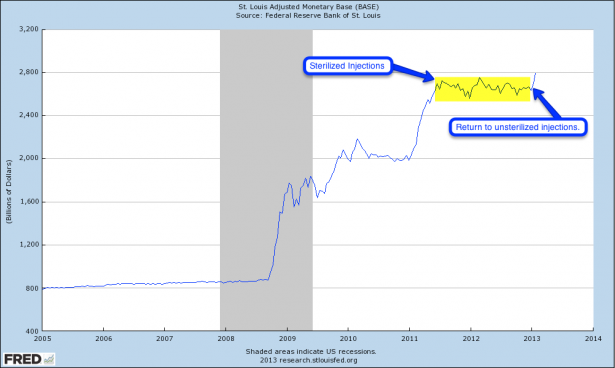Fed Versus ECB
Fed Versus ECB
Two weeks ago I posted a long overdue update on the Federal Reserve’s market fuel injection activities. My previous post on the topic had been in October of 2011 and today I would like to address the reason for keeping silent on the subject for over a year.
A few months earlier that year the Fed announced ‘Operation Twist’, a program which would be conducted throughout late 2011 and all through 2012 to further ‘help stimulate the economy’. The term ‘Operation Twist’ isn’t new, it was first used back in 1961 (in a reference to the Chubby Checker song) when the Fed employed a similar policy. In essence it refers the Fed’s initiative of buying longer-term Treasuries and simultaneously selling some of the shorter-dated issues it already holds in order to bring down long-term interest rates.
Another popular term you may have heard in this context is ‘sterilization’. In theory the practice of buying the long end and selling the short end allows the Fed to drive down interest rates without further increase in the monetary base – thus they are calling it ‘sterilized injections’.
Operation Twist has been instituted in two parts. The first ran from September 2011 through June of 2012, and involved the redeployment of $400 billion in Fed assets. The second ran from July 2012 through December 2012 and redeployed a total of $267 billion. The Fed’s reasoning for initiating the second phase of Operation Twist was response to continued sluggish growth in the U.S. economy.
Now last December the Fed stated that it would end the program and replace it with a ‘stronger version’ of its existing policy of quantitative easing – which seeks to lower long-term rates by making open-market purchases of longer-dated U.S. Treasuries and mortgage-backed securities. And that brings us back to our POMO auctions.
If you look at our POMO chart above then you can clearly see the tail end of QE1 as well as the bell curve of injections representing QE2 – all that was done via good old fashioned ‘unsterilized’ injections, thus resulting in a measurable increase in the U.S. monetary base. The St.Louis Fed is kind enough to maintain a chart of just that:
As you can see the Fed went from roughly $800 Million to about $2.8 Trillion between 2008 and 2011. Since then this chart has been pushing sideways, suggesting any injections were done via Operation Twist. If you look closely however you can see a sudden and steep rise over the past few weeks, and the same is visible on my POMO chart above. Apparently there has been yet another policy change and the Fed is now back to full scale unsterilized market injections via POMO auctions. And those means more slosh in the system which in turn provides more speculative fuel for asset purchases. Thus keeping a close eye on the Fed’s POMO activities has once again become relevant to our trading activities.
To dumb all of this down let me simply state that being short equities during active periods of POMO purchase activity is a losing endeavor. If you are looking for evidence – in January I counted 17 days of ‘coupon purchases’ (excluding one TIPS which I usually disregard) – there was not one single sale. The implicit (and perhaps intended) effect of which was a rise of 88 handles in the S&P 500, a 1,015 handle rally in the Dow Jones Industrial, and an all time high in the risk-on Russell 2000. Fortunately we here at Evil Speculator were prudent enough to not step in front of this speeding bus.
In case you are wondering what February may hold for us – here’s the Fed’s POMO schedule for this month. And once again we’re seeing bumper to bumper POMO purchases on the roster and not one single sale. The Fed’s message to the bears: Don’t screw with us – we will frilling crush you.
Now that is not the end of the story – there is another factor we need to consider and it’s the actions of the ECB on my side of the Atlantic. Draghi has been cooking his own stew of sterilized injections by swapping a portion of the ECB’s on-balance sheet exposure for an unlimited off-balance sheet commitment via the Outright Monetary Transactions program. He’s doing this by concurrently offering one-week deposits to the banking system. Banks bid competitively for the deposits, thus permitting the ECB to withdraw from circulation an amount of money equivalent to what it has spent via OMTs.
Fed Versus ECB
So why do we worry about all this? Because when we produce a ratio of the balance sheet of the Fed against that of the ECB it almost exactly tracks the gyrations of the EUR/USD (chart donated by John – I’m currently compiling my own):
There’s a pretty enlightening Wall Street Journal article on the topic which makes that very point. Particularly interesting are the rather distinct ratio divergences vs. the EUR/USD which should make for some nice contrarian trade opportunities.
If you are an equities trader (and if you are reading this I assume you qualify) then it is important for you to embrace the fact that you are implicitly trading the EUR/USD. The chart above makes this rather clear – the moment the Dollar rises against the Euro equities suffer – when it falls equities are on the rise. And it’s not just all about the Federal Reserve’s actions – at the end of the day it really boils down to which side is printing more. At the moment the Fed is once again expanding its balance sheet while the ECB has been reducing it. That means a (relatively) stronger Euro, a weaker Dollar, and thus a continued rise in equities.
The current P&F target on the FXE is 139.5 – and given both the Fed’s and ECB’s activities I have little doubt that we will fulfill that price objective and perhaps more. And as long as the Dollar’s fall continues we should expect to see higher prices for commodities as well as equities across the board. And most likely higher prices as well at the pump and at the cash register.
Cheers,




















